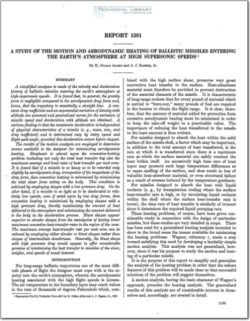NACA-Report-1382

- Version
- 252 Downloads
- 2.01 MB File Size
- 1 File Count
- December 4, 2015 Create Date
- December 4, 2015 Last Updated
National Advisory Committee for Aeronautics, Report - A Comparative Analysis of the Performance of Long Range Hypervelocity Vehicles

Long-range hypervelocity vehicles are studied in terms of their
motion in powered flight, and their motion and aerodynamic
heating in unpowered flight. Powered flight is analyzed for
an idealized propulsion system which approximates rocket
motors. Unpowered flight is characterized by a return to earth
along a ballistic, ship, or glide trajectory. Only those trajectories
are treated which yield the maximum range for a given velocity
at the end of powered flight. Aerodynamic heating is treated
in a manner similar to that employed previously by the senior
authors in studying ballistic missiles (NAOA Rep. 1381),
with the deception that radiant as well as convective heat transfer
is considered in connection with glide and skip vehicles.
The ballistic vehicle is found to be the least efiicient of the
several types studied in the sense that it generally requires the
highest velocity at the end of powered flight in order to attain a
given range. This disadvantage may be oflset, however, by
reducing convective heat transfer to the re-entry body through
the artifice of increasing pressure drag in relation tafi-iction
drag—that is, by using a blunt body. Thus the kinetic energy
required by the vehicle at the end of powered flight may be
reduced by minimizing the mass of coolant material involved.
The glide vehicle developing lift—drag ratios in the neighbor-
hood of and greater than 4 is far superior to the ballistic vehicle
in ability to convert velocity into range. It has the disadvantage
ofhavingfarmoreheatconvectedtoit;however,ithasthe
compensating advantage that this heat can in the main be
radiated back to the atmosphere. Comeguently, the mass of
coolant material may be kept relatively low.
The ship vehicle developing lrft—drag ratios from about 1 to 4
is found to be superior to comparable ballistic and glide vehicles
in converting velocity into range. At lift-drag ratios below 1 it
is found to be about equal to comparable ballistic vehicles while
at lift—drag ratios above 4 it is about equal to comparable glide
vehicles. The ship vehicle avperiences extremely large loads,
however, and it encounters most severe aerodynamic heating.
| File | Action |
|---|---|
| naca-report-1382.pdf | Download |

Comment On This Post